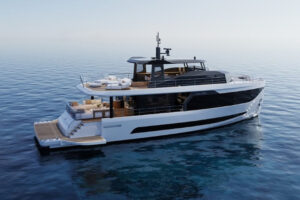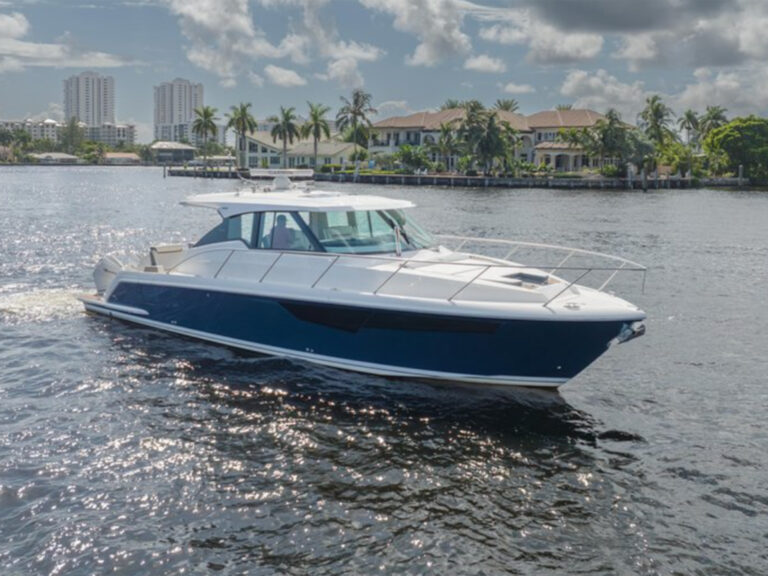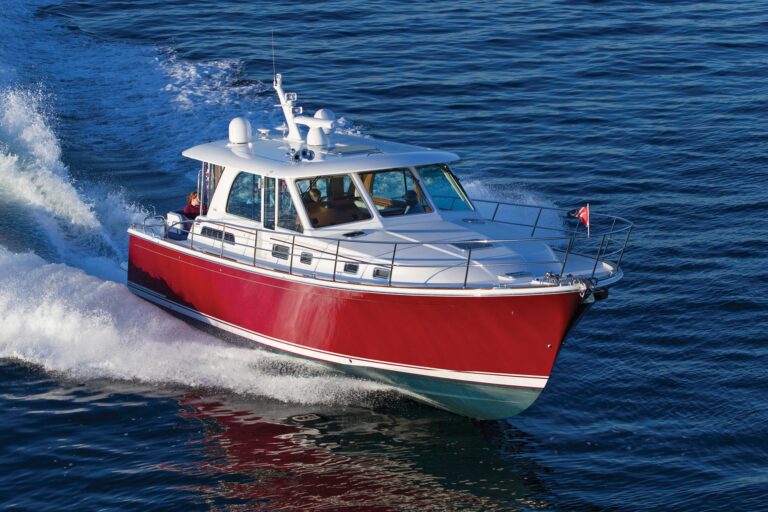The newest delivery from Moonen Shipyards is proof that the theory of evolution is valid, at least in yacht building. Better yachts don’t come from “big bangs”, but rather develop from the designs of successful predecessors. Far from revolutionary, the 84-foot motoryacht Gogar Lass is a flush deck cruiser with a round-bilge displacement steel hull, designed for long-range cruising rather than speed. Yet there are many clues that she is a step beyond previous launches from the Dutch yard.
Based on Moonen’s 72- and 83-foot motoryachts, Gogar Lass is the second in the series, following the Moonen 83 Mimi, which was launched late last year. Moonen is one of the few builders still producing custom yachts under 100 feet, which allows improvements on each individual design. With Gogar Lass, Moonen set out to make a quiet design even quieter, and to improve turning time with a feature seldom used on yachts.
When I saw Gogar Lass under construction in Hertogenbosch, Holland, before she launched this year, that feature was one of the first to catch my eye: a pair of Barke foil rudders. Working on the same principle as the flap on an airplane’s wing or the articulating trailing edge of a high-performance wing sail, the after third of a Barke rudder is a separate piece hinged to the main portion of the rudder.
When holding a steady course, the flap is in line with and forms a part of the overall foil shape. When the wheel is cranked over, an internal mechanism forces the flap to a greater angle than the forward section, yielding the hydrodynamic equivalent of a cambered foil. This increases lift, or turning force, and results in faster turns with a reduced turning circle diameter. It also augments the effectiveness of propeller thrust when maneuvering. As this provides some of the advantages of a stern thruster without the added expense and complication, I think it may make sense for other yacht builders.
Also apparent at the stern was a generous amount of clearance between the propeller blade tips and the hull. The clearance was about 30 percent of prop diameter; standard is 15 to 20 percent. The purpose of the extra spacing is noise and vibration reduction, another of the evolutionary steps Moonen took with Gogar Lass. The five-blade propellers are swept back with high skew and include special unloaded blade tips to further reduce hull vibration.
Carrying the propellers and shafts are oil-bath tubes welded into single-leg struts. After these are fabricated, Moonen technicians test them to ensure their natural frequency does not correspond to the propeller blade or shaft operating frequency, which could lead to excessive vibration.
Other components in the quest for quiet include insulation of the engine and accommodation spaces and isolation of all machinery from the hull structure on resilient mounts. Also part of the program is operating the Caterpillar main engines at their 1800 rpm reduced-horsepower B-rating, which will also result in longer engine life. According to Moonen’s sea trials, sound levels at the 11.2-knot cruising speed are a subdued 59 decibels in the saloon, and less than half that in the owner’s and VIP staterooms.
Visits to Moonen Shipyards are always a pleasure for the technically oriented. The company’s managing director, Emile Bilterijst, is a naval architect who delights in sharing details of his yachts. Knowing that Gogar Lass was a collaboration between outside designer Rene van der Velden and naval architect Stolk Marimecs, I asked Bilterijst if he also had a hand in the engineering. With a smile, he quickly pulled out a binder filled with notes, charts and graphs of such minutiae as sectional area curves and hull coefficients.
Although Bilterijst doesn’t prepare the drawings himself, it is his continued attention to the basics of design that makes yachts such as Gogar Lass possible. Her added propeller clearance was achieved without excessive draft or hull pockets by allowing the hull’s lines to rise nearly to the waterline aft. This, in turn, was possible only because of an early decision to place crew quarters at the stern and locate the engineroom, and its concentrated weight, closer to amidships.
The resulting hull is a full-bellied form with tapering ends. This yields a relatively low prismatic coefficient for reduced resistance at displacement speeds, appropriate to cruising yachts such as Gogar Lass. As I sighted along the hull’s smooth lines, Bilterijst confirmed what I suspected. This is not a developed hull form, which consists entirely of two-dimensional curves and is easy to plate with sheet materials such as steel. Rather, the hull has significant areas of compound curvature, requiring more work but allowing a less restrictive shape.
Other Moonen yachts of similar size carry semi-displacement hulls or planing hulls of aluminum, each appropriate to its speed. This approach-matching hull form and materials to purpose-has long been a hallmark of Moonen.
The yard delivered the 120-foot White Heaven III last year, but most of its production is between 70 and 110 feet LOA. This is in line with the yard’s stated goal, to “create pocket megayachts of the highest standard, combining traditional elegant styling with today’s requirements in terms of comfort and state-of-the-art equipment. To fit a cruising yacht into a planing hull, for example, just to save a bit of work or cost, or to utilize existing designs or molds, is not part of the Moonen plan.
Even if a yacht is part of a standard series, as is the Moonen 84, each launch has her own interior design, outfitting and equipment package. Gogar Lass is similar to Mimi, but sports a clean minimalist cherry interior, stained dark with a satin finish. Mimi has a closed galley and a more formal layout on the main deck, while Gogar Lass carries an open galley with a casual bar at the corner of the saloon and dining area. Most of the joinery is constructed at the yard, so special owner requests are no problem.
Gogar Lass carries eight guests in four staterooms belowdecks. The master stateroom is amidships, shielded from the heat and noise of the engineroom not only by a heavily insulated bulkhead but by the master bath and a large hanging locker. A VIP stateroom is forward, and two twin-berth staterooms occupy the space between.
The wheelhouse is separated from the dining area and saloon by the galley and day head. As Gogar Lass is expected to spend many nights under way, this will help keep light intrusion to a minimum. Full side decks and lockers on the foredeck will allow the crew to handle docking chores with ease.
Contact: Moonen Shipyards, (011) 31 73 621 0094; info@moonen.com; www.moonen.com.









